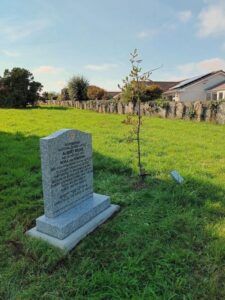
In March 2022, Martin Sugarman, the Chairman of the Jewish American Society for Historic Preservation’s U.K. branch, shared with me a contact he had received.
Susan Soyinka, from Penzance, Cornwall, had contacted him about possibly funding a Remembering Stone for Albert and Rosa Reuss. The Reusses were Austrian Jewish refugees who escaped to the U.K. as the dark, bloody claws of the Nazis were about to envelop them in the Holocaust. They were among the very lucky and far too few who made it to sanctuary in the U.K.
Albert Reuss was an accomplished artist. Susan wrote a very highly regarded biography about him.
Albert and Rosa made a new life for themselves in Mousehole, Cornwall. Though Albert returned to painting with Rosa’s vital emotional support, the shadow of the Nazi terror and the destruction of their lives never left them. Albert and Rosa lived as one but never had any children or much family that survived.
Susan approached Martin asking if JASHP-UK would be willing to help memorialize the Reusses with a Remembering stone. After their passing their remains were cremated and gently passed into the winds with no memory other than her book.

Martin contacted me in the U.S., inquiring if this was a project I was willing to underwrite. Martin knew my revulsion of the successful Nazi efforts that converted the lives of millions to “Luftmenschen,” people who are nothing but ashes blowing in the wind. The victims had nothing on the ground to teach about who they were and what happened.
I responded positively to the inquiry.
I explained to her, “I see them as representative allegories of the trauma of the refugee experience. Though a Reuss Remembering Stone is focused on the Jewish story, the need is to understand what is happening to millions in times of war. The uprooting, the intolerance, the hate, anger, and desperation should never be forgotten or misunderstood.”
Susan steered the effort for the stone. She recommended a very appropriate setting in the 12th-century English Churchyard of St. Pol-de-Leon Church, Paul Parish, Penzance.
The Remembering Stone was placed adjacent to a Tree of Memory planted by the Association of Jewish Refugees, U.K. The Association had planted the tree in January in honored memory, in gratitude, to the people of Cornwall who took in over 100 Jewish refugee children 80 years ago. The text of the Stone is as follows:
Jewish Artist
Albert Reuss
and his devoted wife
Rosa nee Feinstein
who fled Vienna to England in 1938
to escape the Nazi Holocaust.
They moved to Mousehole in 1948.
Because of Rosa’s love and support
Albert continued to paint until the end.
Rosa died in 1970 aged 78
Albert died in 1975 aged 86
פותח לנו שערי רחמים
Open to us the Gates of Mercy
Jewish American Society for Historic Preservation
It took a few months of doing. In September 2022, the Remembering Stone for Albert and Rosa Reuss was dedicated. The Parish Priest, Andrew Yates, with extraordinary understanding and consideration, worked closely with Susan. Together, they saw the Remembering Stone become a reality.
The stone will be there for hundreds of years to tell of the Holocaust to the future and to the future’s future. The Reuss are Luftmenschen no longer.
A few days ago, Susan wrote to me. She had been surprised and touched by a previously unknown effort. Andrew shared new pictures of the Reuss Remembering Stone and the adjacent Tree of Memory.
Flowers, yellow crocuses, the harbingers of spring, of life renewed, poked their beauty from the still cold winter’s ground, bloomed about the Reuss’s stone and the Tree of Life.
In November, unbeknownst to us, children of Mousehole School had come to Paul’s to plant Yellow flowers, Crocuses, specifically at the Reuss’ Remembering Stone and the Tree of Life. They were part of the International Crocus Project (https://www.holocausteducationireland.org/crocus-project).
“The children had joined more than 100,000 schoolchildren across Europe, planting crocus bulbs – each flower a yellow star – to remember the 1.5 million Jewish children who died in the Holocaust. They had come as part of the International Crocus Project.
“The yellow flowers recall the stars that Jews were forced to wear under Nazi rule.”
Crocuses bloom in mid-to-late winter to approximate International Holocaust Remembrance Day.
“When people admire the flowers, the pupils explain what they represent and recall the children who perished in the Holocaust. This project is supported by the Department of Education.”
The International Crocus Project is a tangible way of introducing young people not just to the Holocaust but to the universals — learned a very hard way, universals that must never be forgotten. “The Project raises awareness about the dangers of racism and discrimination. It encourages learning about tolerance and respect. Crocuses flower each year, (multiplying in numbers) adding beauty and a profound memorial.”
Adds the Tree of Life, the Remembering Stone, the Children of Mousehole: “Remembering, Learning, Remembering the meaning of the Holocaust today, and for tomorrow.
Jerry Klinger is the President of the Jewish American Society for Historic Preservation. www.JASHP.org